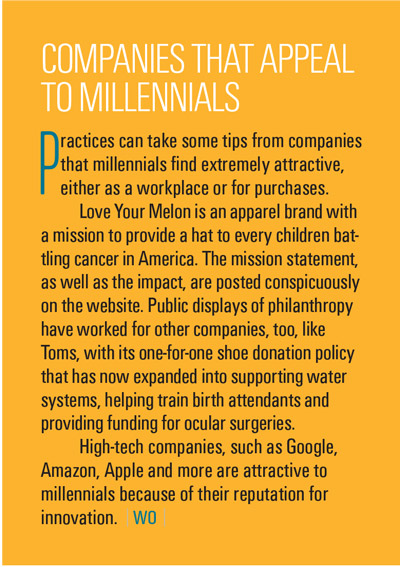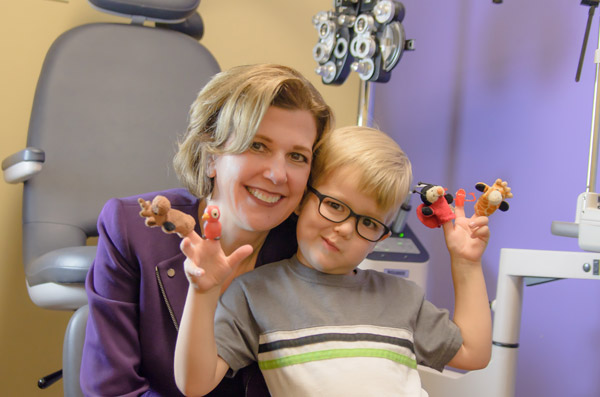

Carole Burns, OD, FCOVD, realized the need to retool the office culture if it was going to be the kind of place to retain millennial employees. “Fifty percent of our hires are millennials,” she says, noting the percentage will climb. There are 80 million of them, and 50 million are already in the workforce. “Most have no experience in the medical or eye care field,” she says.
But Dr. Burns actually considers that an asset. Get the right millennial candidates on board and your practice can thrive in new ways, she says. “This is the most diverse demographic. One-in-three millennials is a minority. As much as you can categorize any group of individuals, millennials have extreme feelings about what the workplace should be. They’re confident, civic-minded and committed to a company that shares their values.”
But the retention strategies that may have worked with staff previously are not likely to have the same impact. Dr. Burns is one of
nine partners at Professional VisionCare, a three-location practice in Westerville, Ohio, that focuses on primary care and vision therapy. Two of the partners are millennials, too.
Hazards of labeling
No one likes to be labeled, and millennials don’t like the negative connotations that have come along with the name, mainly the short
attention spans that come from growing up as digital natives. But that very upbringing is also what forced Dr. Burns and many other ODs to rethink the best strategies for training, encouraging and retaining millennial employees. “I believe that the reason that they shift
jobs so quickly isn’t that they’re bored easily but they’re not finding what they want in their workplace,” she says. In other words, if millennial employees are leaving your practice frequently, well, ahem, they’re bored with your practice. “They want to give back. They don’t identify themselves by their work but by who they are and what they do after 5 p.m.,” she says.
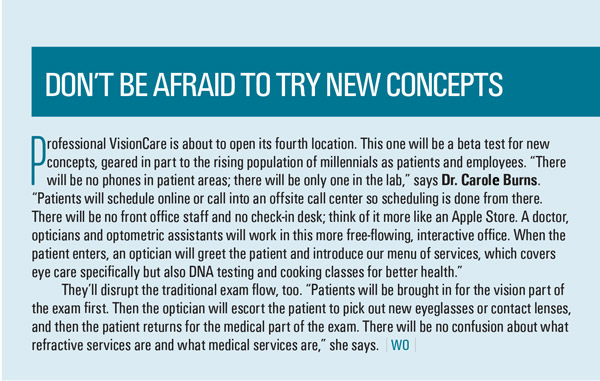

The training conundrum
ODs want well-trained staff. That’s essential to the success of the business. But some doctors feel like they’re between a rock and a hard place. Why invest in training an employee who is probably not going to stick around long? Drop that mindset, says Dr. Burns. “You need to train to be the fullest potential possible. If you’re losing employees, do not blame it on the idea that you’ve overtrained them.”
In fact, Dr. Burns says, a well-organized business is going to have greater appeal than a disorganized one to millennial employees. “They don’t want to come into an organization that seems disheveled. An excellent training program gives them confidence in the organization and makes them want to stay.”
What comes around goes around
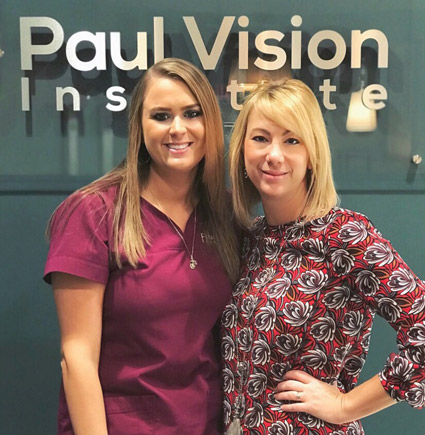

Kristy Woodard began working as a tech for Sara Brigman, OD, in a corporate practice
location. “I started with no experience whatsoever, but I had management and business experience, so I applied,” says Woodard. “Dr.
Brigman recognized my potential and my interest to learn more, so she taught me everything. I began to know what she wanted with
each patient; we worked so well together,” says Woodard. Into the fourth year of working together, she began to realize that she had reached the peak of what she could do at that practice location, and, reluctantly, she told Dr. Brigman she was going to work at an ophthalmology office where she could advance her skills more.
“I cried,” says Dr. Brigman. “My patients cried. Surly old men were giving her hugs.” She was that special, she says. “You get used
to turnover among staff, but sometimes you get people who are so easy to teach because they want to learn. I knew she would soak up whatever I asked of her. She’d keep lists as we walked around together. She could draft my assessments and plans.”
This story has a happy ending. Dr. Brigman was also planning a career change. She couldn’t say anything to Woodard, however. Several months later, Dr. Brigman joined Paul Vision Institute in Wilmington, North Carolina, bringing her contact lens specialty to the practice. She needed a technician, and she knew just whom to call. Woodard accepted, and the two picked up where they left off—but with more opportunities for each of them.
Just rewards
Woodard joined Dr. Brigman because the doctor inspires her. It’s difficult to identify and incentivize inspiration, however, and that’s where Dr. Burns says that practitioners need to become a little more creative. “There are business owners whose idea of a reward is a great dinner—with them. Well, a lot of employees don’t want to spend more time with their boss. Twenty years ago, having dinner with me was a great event for my employees. Today, it’s a hostage event. They have other things they want to get home to. They want to be a part of something bigger than their job.”
Her practice holds “just because” events. “We take recommendations from employees, and we simply do it. We don’t negotiate a date that’s good for everyone. We say, ‘We’re going bowling Friday,’ or ‘It’s karaoke night,’ or ‘‘We reserved an escape room this weekend.’” This kind of informal event requires a sea change adjustment in the perception of the return on investment. “Don’t think you have a failed event because six of your 50 employees showed up. The six who came are delighted you listened to a recommendation, and the 44 who didn’t are happy that you didn’t make them go. These events should be ‘just because’ someone wanted to do it.”
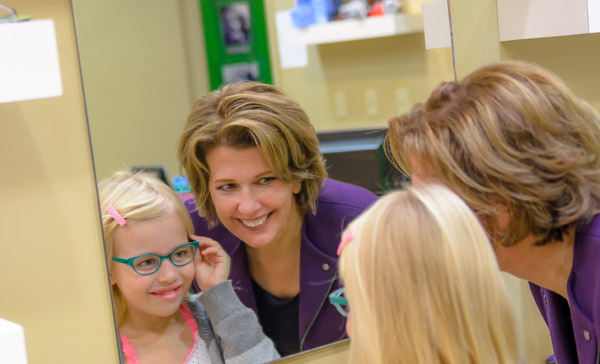

The practice sets aside funds for these just because events. “We know not everyone is going to come, but we’ll never consider an event unsuccessful because of the numbers. Two people went? Hurrah. It made them happy.”
The practice also holds community events, and these are more formalized, but the impetus still starts with the employees. The practice looks at ways to help community organizations and then sets out to figure out how to do it. “We told the city that we
wanted to plant trees. We offered to buy a tree for every patient who got an eye exam in August, and the city sent out postcards, too. We post these events on social media and even in traditional advertising,” she says.
A culture shift
The first step in encouraging a culture shift that incorporates all employees is to listen to your employees. Dr. Burns’ office has a bulletin board with $50 in crisp $1 bills, each one folded and held in place with a pushpin. The board is titled “A dolla for your holla.” When an employee has an idea about a community event that the practice can be involved with, he or she can leave the idea on the board and take a dollar. If an employee has several ideas, he or she can take several dollars. “They’re getting heard and they see that we’re implementing the things that they or their colleague suggested. It starts to say to the staff that we’re listening to you.”
Before a practice owner starts to worry that this is going to add big bucks to the expense sheet, relax, says Dr. Burns. “Some of these events cost nothing. One person suggested that we write letters to veterans. So one Friday afternoon this past summer—when we normally close early—40 people showed up. Some employees brought their kids. We had a table full of paper and markers and other supplies, and they wrote letters,” she says.
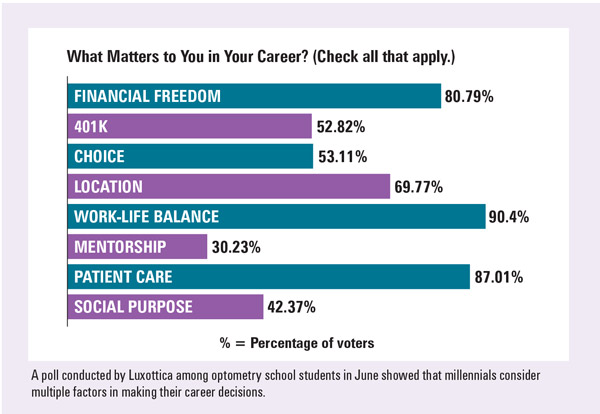

Your mission statement is not their mission
Dr. Burns is proud of the practice’s mission statement—we change lives through innovative vision care—and the employees know it and understand its value. But the practice mission statement is not their life’s mission. “They need an inner purpose for coming to
work. They want to know how they are bettering their fellow man and how does their work fit into a bigger picture.”
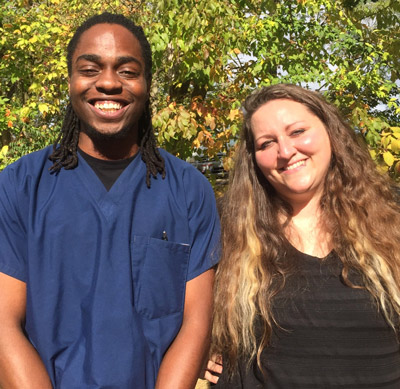

Two of her millennial employees told Women In Optometry what made them choose and stay with the practice. Raquel Miller, practice director, says that the visible, measurable impact that the practice has on the community was the attraction. “We went over that commitment during the interview, and, in the seven years that I’ve been here, I’ve become even
more invested in the practice because of that.”
Davon Harris, optometric assistant, agrees. “The doctors practice what they preach. They told me in the interviews that this was a team effort, and it’s true. I’ve worked in places before where you’re on your own, but here, if you ask someone for help, you’ll get it.”
They also believe that they’re delivering value to the practice. “I bring my enthusiasm,” says Harris. “It’s my joy to work in a place where everyone’s character meshes together.” Miller adds that millennials want to be unique and feel important. “We’ve changed some of our company culture to reflect how we make an impact. It’s not just the doctors’ roles that are important. So we’re pumped and excited to do what we’re called to do.”
Millennials will push practices to be better, says Dr. Burns. “They’ve mandated that we become more giving. Looking at the success of the company is not the only end for them. They want to see it as a means to helping others. As long as they see that happening, they’re going to want to help and promote your business.”
